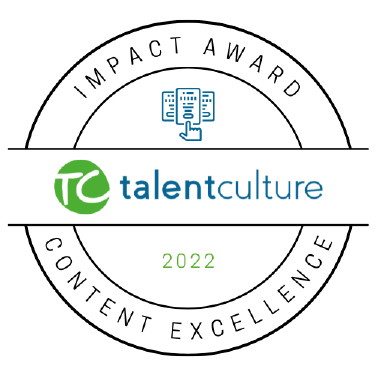 What is a great “place” to work today? With many abandoning the office tower or business park cubicle office, we’re increasingly emerging from an era of great workplaces to the new territory of worker-centricity. While some thought the great place to work was about amenities (commuter buses, reduced or free food, and onsite everything), we’ve known something else all along–supportive leadership in the work environment is key.
What is a great “place” to work today? With many abandoning the office tower or business park cubicle office, we’re increasingly emerging from an era of great workplaces to the new territory of worker-centricity. While some thought the great place to work was about amenities (commuter buses, reduced or free food, and onsite everything), we’ve known something else all along–supportive leadership in the work environment is key.
Executives in great organizations believe that every employee benefits from outstanding leadership. Engagement is dependent on leadership, as Gallup’s research consistently reports that nearly 70% of employee engagement is within a manager’s control. Managers who prosper in today’s hybrid work environment will boost engagement with the five core leadership practices.
1. Building and sustaining trust.
The core of the coming modern enterprise is an authentic leader’s ability to gain and establish trust. The 2021 Edelman Trust Barometer revealed declining confidence in social institutions and organizational leaders worldwide. The world’s two largest economies, China and the U.S., showed significant decreases in the trust of both politicians and corporate executives. Employees who trust their leaders demonstrate greater satisfaction, loyalty, and involvement, all antidotes to undesirable talent drain and loss.
Trust fuels the teamwork and progress that leads to innovation, a key determinant of long-term growth and survival. Managers erode trust when they are not honest and truthful, and trust is difficult to regain. Trust erosions lead to decreases in integrity, and we don’t fully engage with those we don’t trust. Successful leaders engage and enroll people in goal-driven missions that spark collaboration leading to improved teamwork and productivity.
2. Leading from values.
When was the last time you considered what your team or company holds in high regard? Typically, we keep our values in the highest regard and build reward and consequence systems that reflect leaders’ values. Engineers and scientists, for example, are recognized for their accomplishments with honorific titles or other expressions of acknowledgment. At the same time, sales and marketing professionals might reap great expense-paid prizes. The more selective the set of values, the more they shape performance.
Values help people connect to organizations and the world in ways more significant than individual accomplishment and effort. For example, if a startup values frugality, people will likely be encouraged to monitor capital and resource consumption. When a manager recognizes effort routinely, the manager demonstrates care and will actively bolster employee satisfaction and engagement. Values guide the decisions we make and the actions we take. Leaders gain faster results and build better relationships by consistently articulating and aligning colleagues to shared values.
3. Creating communities.
While there is truth in the observation that culture eats strategy, growth businesses are now shifting to community thinking within the work environment. A community invites deeper levels of belonging and commitment, while culture implies one-way approaches. While leaders will never underestimate the influence of culture on work processes — or how things get done — they will invest in creating communities where the practices of improvement and resilience thrive.
Communities, not cultures, pay attention to wellbeing, commitment, innovation, and revenue. As they do, expenses and problems decrease along with skepticism and stress.
Managers and leaders who succeed facilitate employee involvement in decision-making and product and service delivery. Managers expand their capacities for including and involving others and encourage broad knowledge and skill sharing. When managers lead the way in strengthening the bonds, performance vitality and output increase. Employees improve their connections among their colleagues and partnerships between leaders and their teams thrive.
4. Growing transition readiness.
Most people can let go of the past and successfully embrace a new order or a different future. However, the time between a specific history and an unpredictable future creates and powers uncertainty. In the face of not knowing, we fill in the gaps to reduce the psychological tension that arises with an unknown future. The remedy to not-knowing is to equip a generation of leaders with the knowledge and skill to navigate uncertainty successfully.
A manager successful at helping others through transitions possesses self-awareness and openness to change and growth through learning and development. These managers refuse to see opportunities and people as problems but rather as contributors. When work is perceived more like an invitation than a requirement, an organization’s esprit de corps positively changes. Improvements measured by meaningful metrics rise.
5. Maintaining a Customer-First Work Environment
When employees can connect their experience and employment to a paying customer or stakeholder, the commitment to excellence thrives. People want to do their best to deliver a quality product or service to those they feel connected to. Customers and new markets are eternal sources of inspiration when we successfully recruit and involve employees in a customer-first mission. A team’s connection to a customer contributes to the motivation for peak performance. When we care, we act in a customer-first way.
Managers and leaders improve organizational energy by harnessing a customer-first spirit across the enterprise with both customers and employees. When colleagues treat each other as customers, it translates to appealing work environments. A standard of care and excellence replaces indifference created by the isolation many experience in today’s hybrid workplace.
To reawaken work and succeed in the new world of work, we must put these five practices into place to boost engagement. Leadership growth in these action areas contains the kernel of power to transform careers, lives, organizations, and the communities we serve. Begin the journey to building teams and communities on the path to personal and organizational prosperity.
Post Views: 2,770